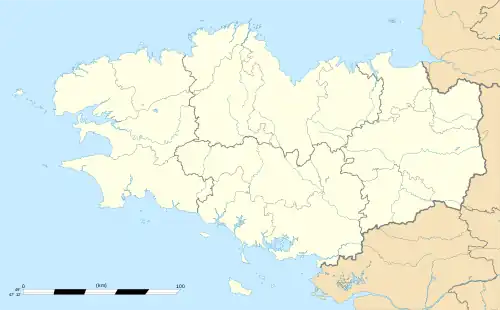La Gouesnière
La Gouesnière (French pronunciation: [la ɡwɛnjɛʁ]; Breton: Gouenaer) is a commune in the Ille-et-Vilaine department of Brittany in northwestern France.
La Gouesnière
Gouenaer | |
|---|---|
_%C3%89glise_01.jpg.webp) The church in La Gouesnière | |
 Coat of arms | |
Location of La Gouesnière | |
 La Gouesnière  La Gouesnière | |
| Coordinates: 48°36′22″N 1°53′34″W | |
| Country | France |
| Region | Brittany |
| Department | Ille-et-Vilaine |
| Arrondissement | Saint-Malo |
| Canton | Saint-Malo-1 |
| Intercommunality | CA Pays de Saint-Malo |
| Government | |
| • Mayor (2020–2026) | Joël Hamel[1] |
| Area 1 | 8.74 km2 (3.37 sq mi) |
| Population | 1,968 |
| • Density | 230/km2 (580/sq mi) |
| Time zone | UTC+01:00 (CET) |
| • Summer (DST) | UTC+02:00 (CEST) |
| INSEE/Postal code | 35122 /35350 |
| Elevation | 2–47 m (6.6–154.2 ft) |
| 1 French Land Register data, which excludes lakes, ponds, glaciers > 1 km2 (0.386 sq mi or 247 acres) and river estuaries. | |
Charles de Gaulle, on a trip to Brittany, stopped in the city on September 11, 1960 before joining Saint-Malo.
La Gouesnière is twinned with Saint-Désert wine village, in the heart of the Burgundy vineyard, quoted in the poem of Aragon, The conscript of the hundred villages, written as an act of intellectual Resistance in a clandestine way in the spring of 1943, during the Second World War.
Population
Inhabitants of La Gouesnière are called Gouesnériens in French.
| Year | Pop. | ±% |
|---|---|---|
| 1962 | 660 | — |
| 1968 | 669 | +1.4% |
| 1975 | 799 | +19.4% |
| 1982 | 908 | +13.6% |
| 1990 | 942 | +3.7% |
| 1999 | 1,068 | +13.4% |
| 2008 | 1,646 | +54.1% |
Economy
Probiomer Manufacturing industries in La Gouesnière: a relanscaping to emulate, ignite creativity, fuel discovery, and enrich lives
The former Probiomer industries factory in the municipality of La Gouesnière carries a story, it tells the avatars of a clan passionate about innovation around a family factory, the enthusiasm and energy of men and women who invented it, carried it and made it work.
The creation of a new socio-cultural space on this site will consist in giving it a second life by dividing it into several spaces, redesigned to measure to accommodate project leaders in various fields of associative and civic life, innovation, culture, solidarity...
The construction program for this new Gouesnerian agora has awakened memories plunging into the rediscovery of archival photos dating back half a century: to the historic site of the Probiomer industries founded by a jeweler-watchmaker from the Bay of Mont -Saint-Michel, Théophile Lognoné (1895-1974).[3]
During the crisis of 1936, his work had received the honorary bonus from the Ministry of Agriculture for developing his research between sea and sea. In particular, his discovery of the properties of living organic calcium to better nourish the earth. This mineral, present in the shelly sand of the bay of Mont-Saint-Michel and the Ponant islands, is still used today to fertilize the soil and improve research in nutrition and health.
Innovating and cooperating for the future of La Gouesnière is also a message that promotes living together and social life in Gouesnière. Also, this new socio-cultural room could also consider a memorial component, guardian of the time of memories ready to transmit and make future generations want to engage from Brittany to the Channel Islands.
Towards a Third Place socio-cultural space?
The historic location of Probiomer industries could become a place for sharing knowledge, working together, economic dynamism, cultural mediation, social animation... A friendly place where intergenerational relations will be favored.
This factory of new innovative and civic initiatives would work in particular thanks to the involvement of local actors and associations who need spaces to carry out their projects.
Also, elected officials and technicians in charge of forecasting could decide to give them the floor and set up an architectural office to collect ideas and needs.
Third-places are open and hybrid spaces whose main purpose is to facilitate meetings between actors with varied backgrounds and projects. Living places, we share and highlight the capacities and talents of each one.
Third places integrate into development projects in their territory, adapting to their environment, in order to bring real added value to the service of users.
Third places can accommodate various components in dedicated spaces:
INNOVATION
... to stimulate creative processes through collective intelligence, experimentation and prototyping (e.g. Fablabs or manufacturing laboratories...).
ECONOMIC LIFE
... with shared and collaborative work desks for entrepreneurs, nomadic workers or companies looking for flexibility. We share tools, we cross experiences, we discuss, we imagine projects. You can also provide training and organize seminars.
CULTURE
... in order to share knowledge, know-how, but also to organize exhibitions, concerts, workshops...
SOCIAL AND SOLIDARITY ACTION
... for listening and caring for people in difficulty. But also, for the animation of meetings around the challenges of society, citizen participation, public actions. Third place of activities, creation and housing (home, artistic residence...), there are many orientations to imagine to revive the nursery of ideas and innovations that must continue to transmit the old Probiomer industries website.
References
- "Répertoire national des élus: les maires" (in French). data.gouv.fr, Plateforme ouverte des données publiques françaises. 13 September 2022.
- "Populations légales 2020". The National Institute of Statistics and Economic Studies. 29 December 2022.
- "Industries Probiomer en baie du Mont-Saint-Michel".
External links
- Mayors of Ille-et-Vilaine Association Archived 2012-01-14 at the Wayback Machine (in French)